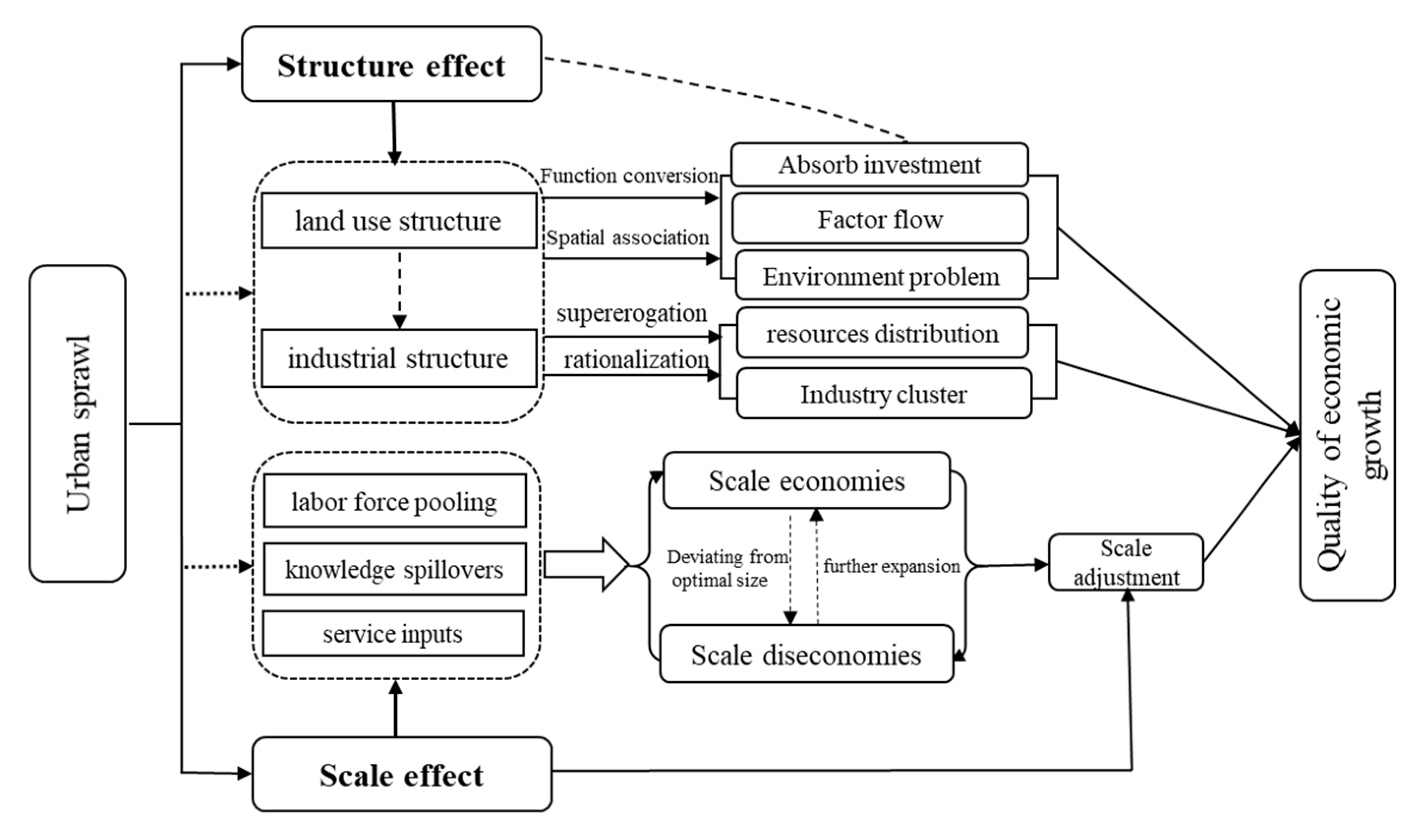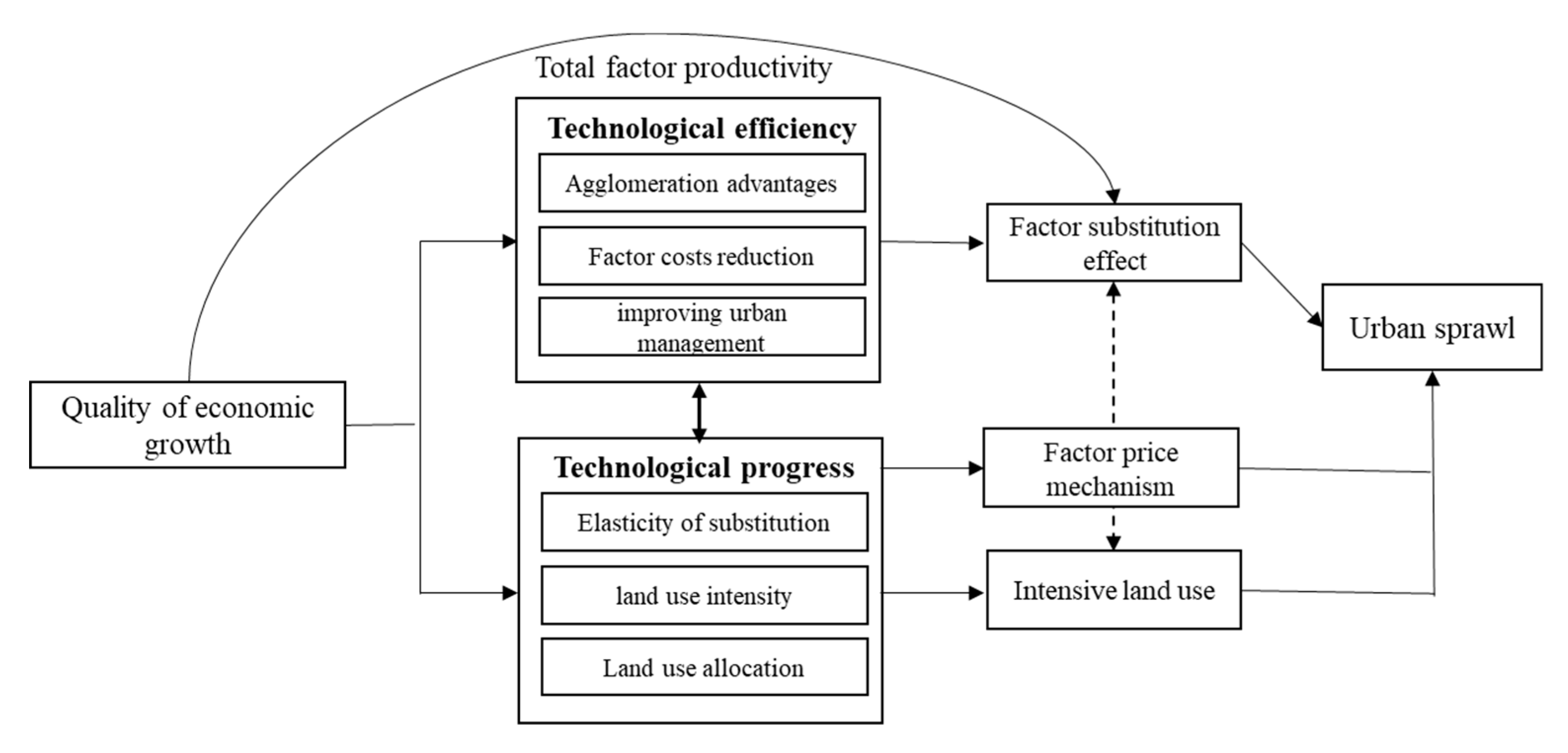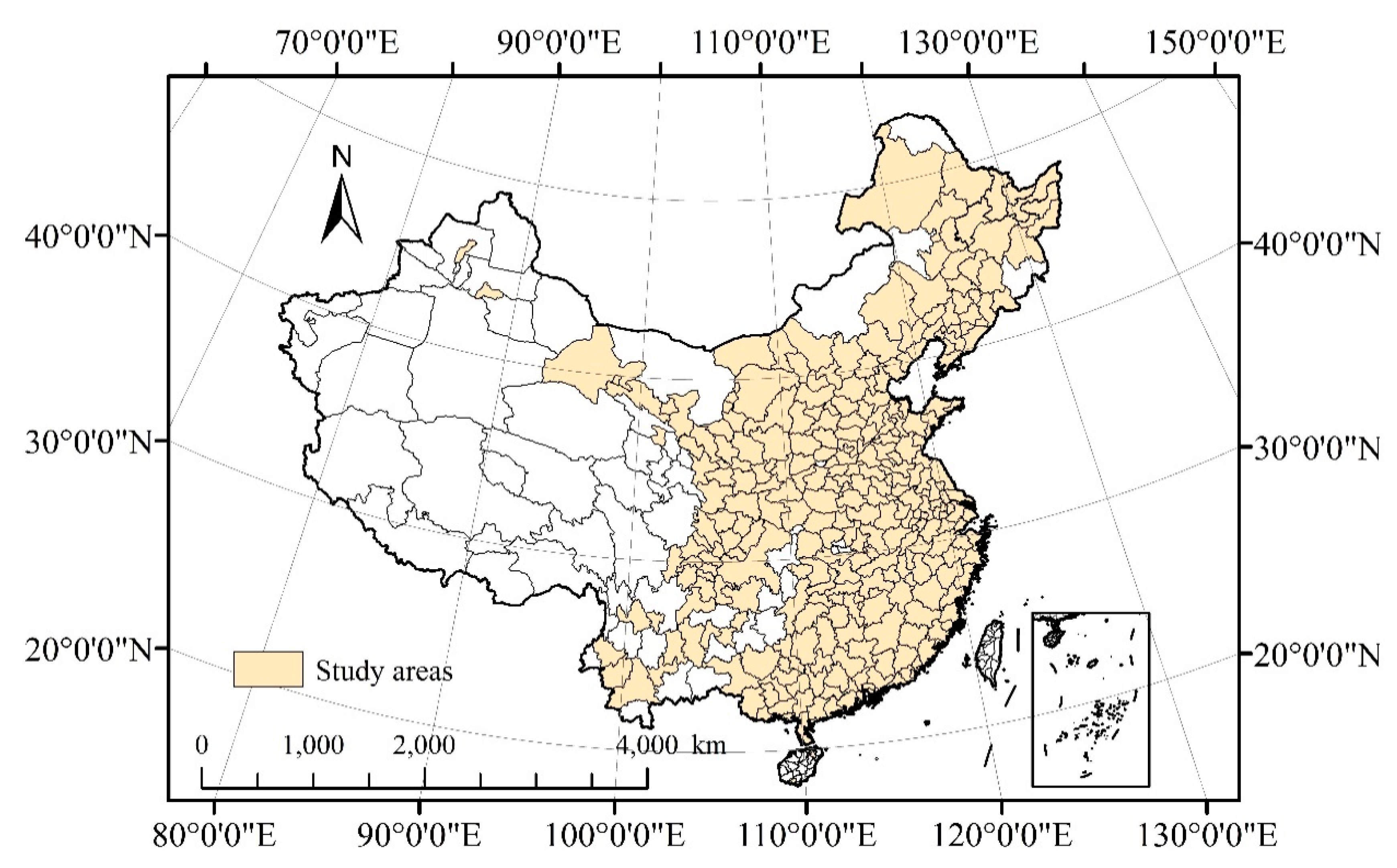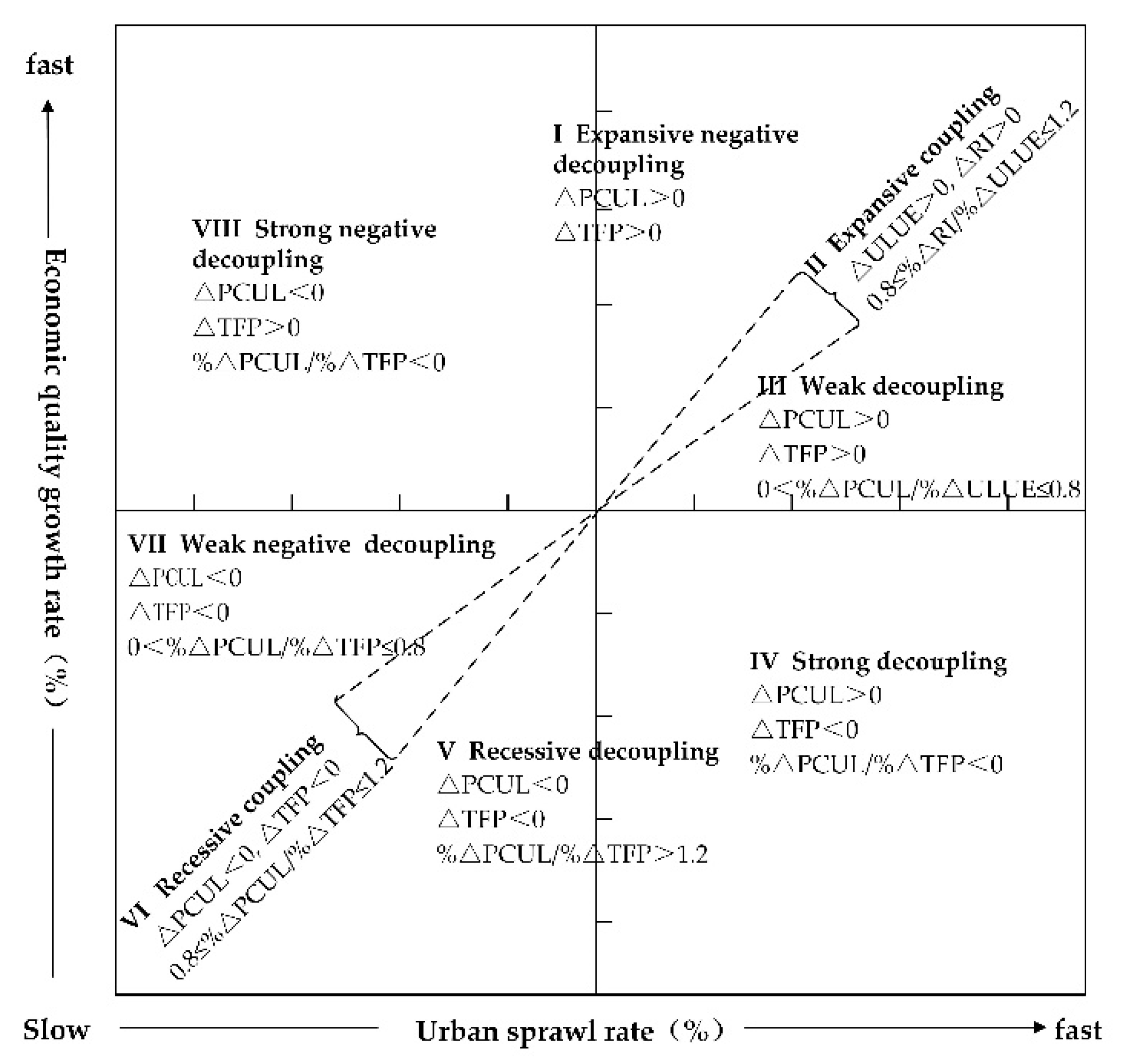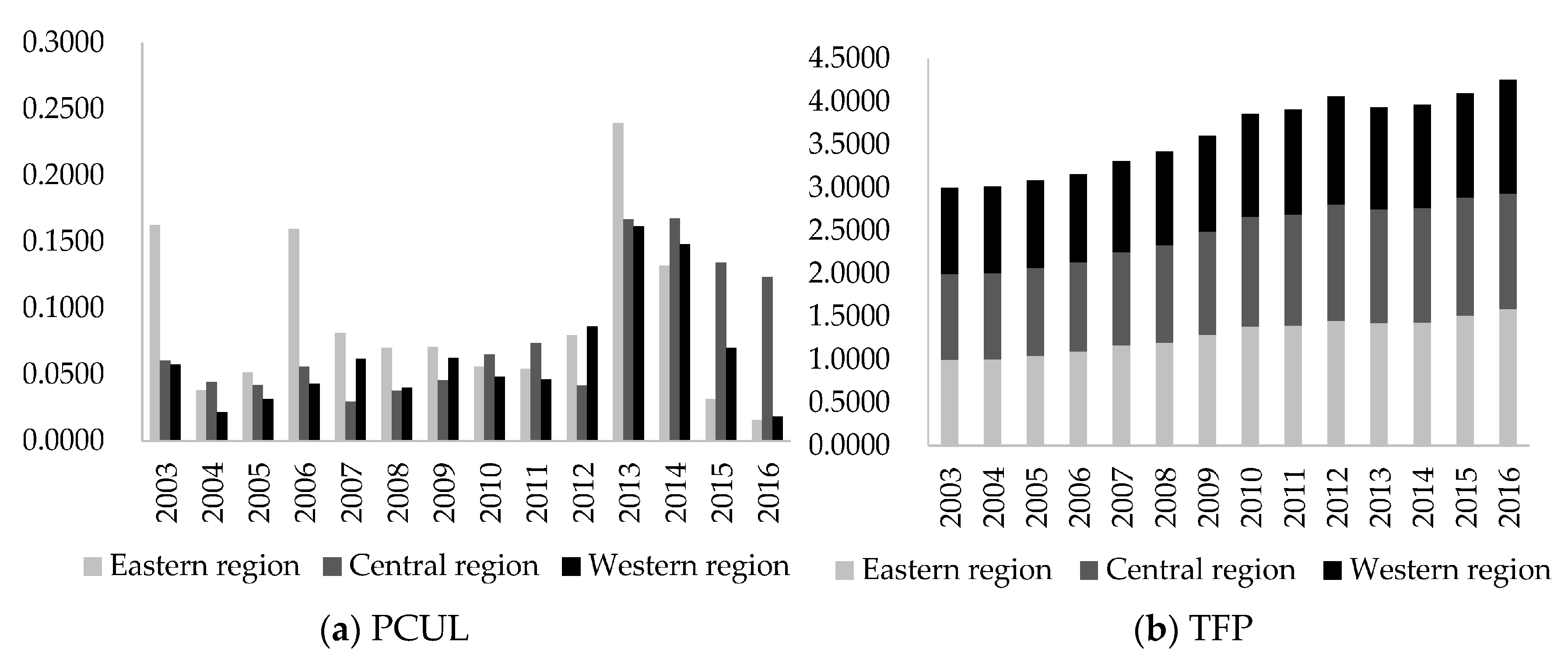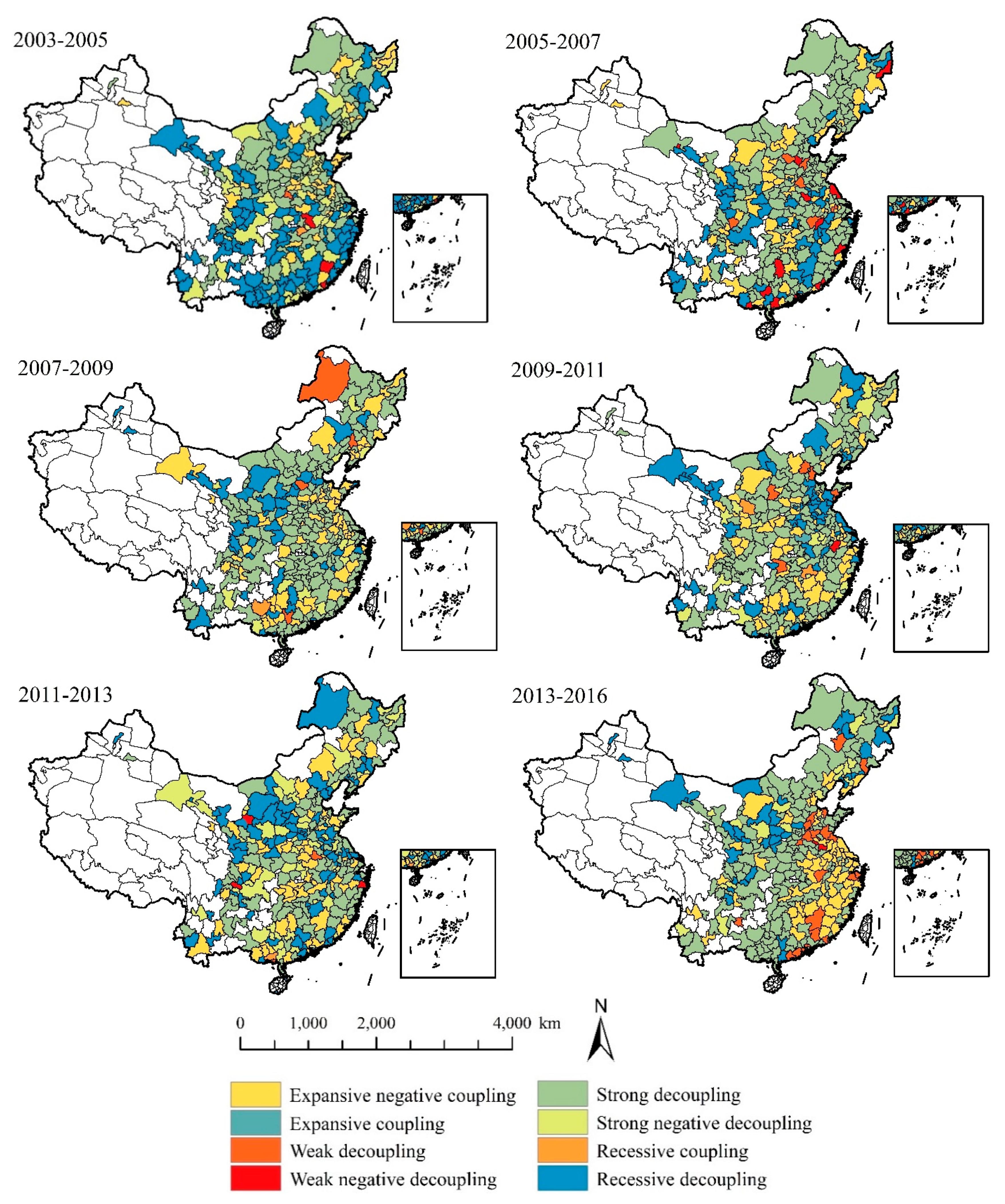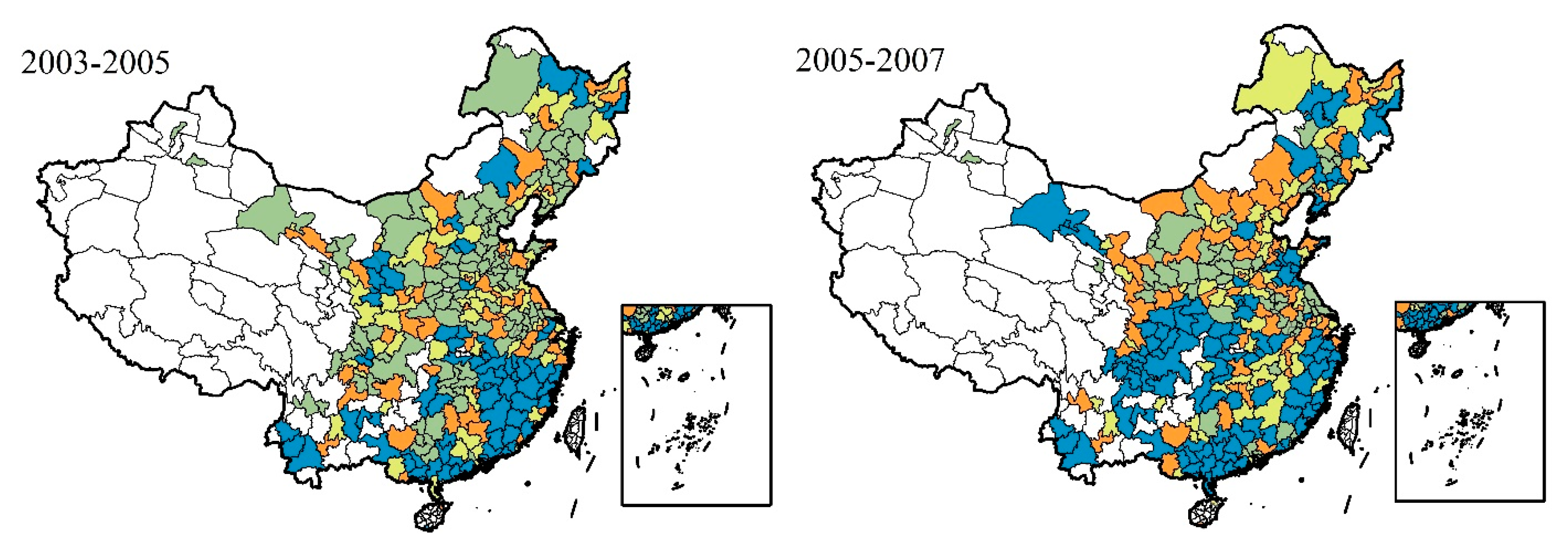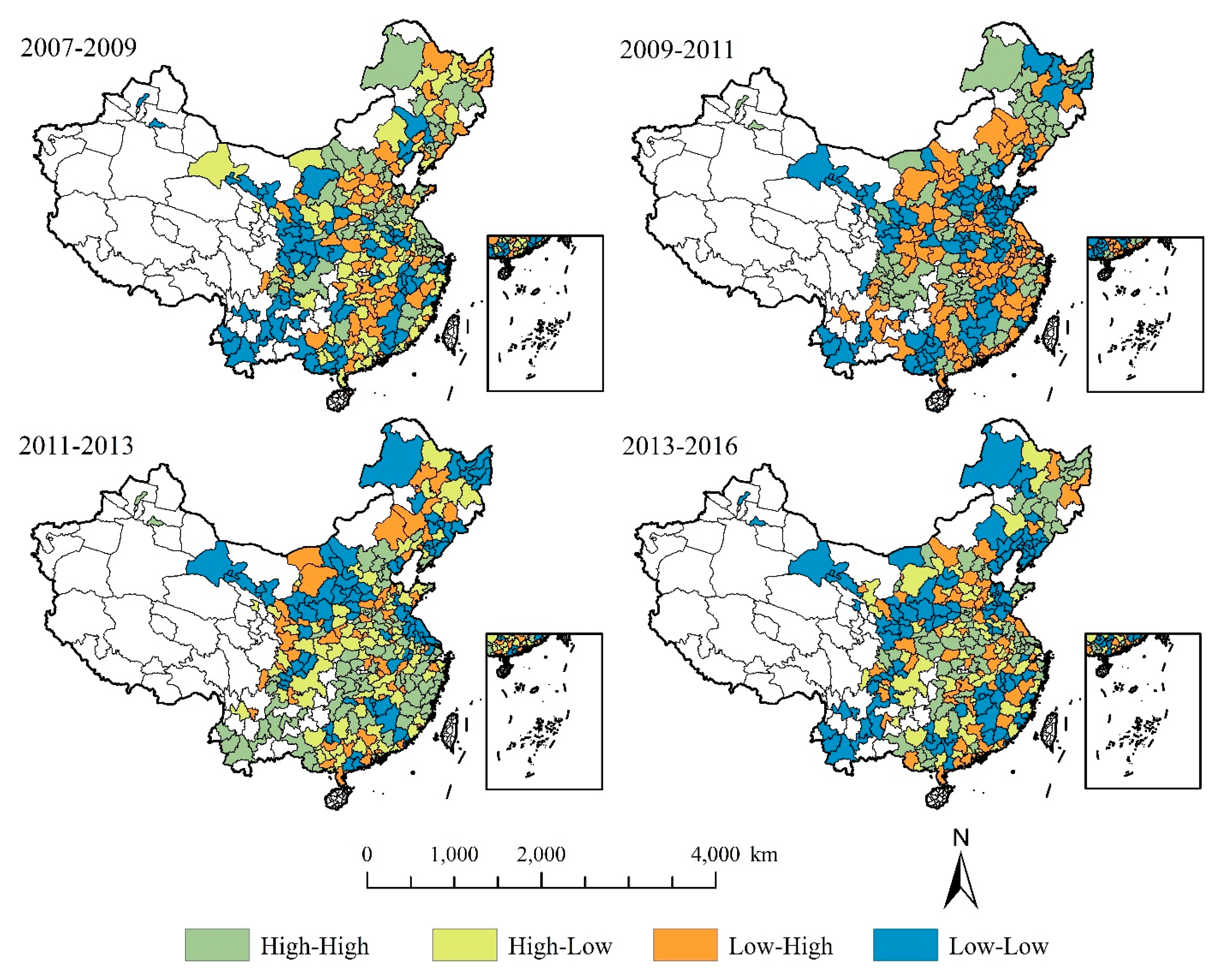1. Introduction
Since the 1990s, China has gradually upgraded its socialist market economy, which boosted advancement of urbanization and industrialization. As a result, a large amount of urban construction land has replaced what was formerly cultivated land, and the pace of urban sprawl has experienced a dramatic acceleration [
1]. From 2000 to 2016, the urban built-up areas of China increased from 22,439 to 54,332 km
2, indicating an average increase of 8.88% (National Bureau of Statistics, 2017). Meanwhile, China’s Gross Domestic Product (GDP) growth rate has exceeded that of major developed countries such as the USA. Since urban land is the carrier of economic growth, the Chinese government increasingly placed greater importance on urban land expansion and its related attributes that contribute to regional economic development [
2,
3]. Such expansion of urban land is a typical phenomenon of developing countries, especially in China [
4]. Moderate sprawl is a central component of “smart growth” due to the presence of population and industry. However, in contrast to GDP growth, land, labor, and environmental costs have increased to their highest levels in history. Moreover, such a “sprawl for growth” pattern has resulted in housing vacancy, redundant industry facilities, and new urban districts that suffer from inefficient utilization. This raises questions whether the ability and potential of urban sprawl can meet the necessary future improvement of China’s quality of economic growth: a process of production efficiency change that values economic, social, and environmental costs, which enables a higher desirable output level and can positively contribute to regional development.
This situation was officially recognized in the report of the 19th National People’s Congress, which alerted the Chinese nation to the importance of economic growth that integrates quantity with quality. Subsequently, the Central Committee and State Council (CPC) issued a series of management instructions to promote the land use control of provided land and to strictly limit the conversion of agricultural land into urban construction land. These policies were aimed to deter the replacement of agricultural land by urban area, and thus were conducive to high-quality economic growth. In fact, as an obvious result of China’s particularly rapid urbanization, the area of designated urban construction land has sometimes exceeded the planning index [
5]. Even more discouraging, despite the average annual increase of built-up districts of 26% in Chinese cities, the GDP growth began to decrease after entering the period of the “new normal”. Moreover, due to a predominant focus on GDP, vast areas of rural land were converted into urban construction land, which had many adverse effects, such as inefficient resource utilization, farmland loss, and environmental deterioration [
6]. Clearly, the pattern of “sprawl for GDP” not only aggravates extensive land use in China, but also affects the high-quality development of the Chinese economy [
7]. It is thus urgent to appropriately decouple urban sprawl from the quality of economic growth and provide insights for improved urban sprawl policies and land use strategies within the context of high-quality development.
The interaction relationship between urban sprawl and economic growth has been a strongly debated issue for a long time. From the perspective of influencing mechanisms, several studies addressed the effects of urban sprawl on GDP growth and mainly paid attention to the macro panel data [
8,
9,
10,
11]. Several micro-level studies have examined the effects of land structure, land price, resource input intensity, and industrial clusters at different urbanization stages on GDP growth [
12,
13]. With regard to the influence of economic growth on urban sprawl, Tu et al. [
9] verified the validity of China’s current administrative system and land institution toward obtaining land revenue from land expansion and development. Few studies quantified the intricate connections between both while focusing on their “coupling” [
14,
15,
16]. One such study was conducted by Ma [
14], constructing a Granger causality test model that identified a mutual promotion between urban sprawl and gross GDP growth. However, Altieri et al. [
17] stated that although urban sprawl could raise the GDP of a city by 12%, this increase would mainly be the result of capital quantity accumulation rather than of the improvement of the total factor productivity (TFP) or technical progress. Urban sprawl is not necessarily beneficial to the quality of economic growth improvement. Similarly, other studies also investigated the quality of economic growth in the urbanization process [
18,
19]. In addition, Zhao et al. [
20] emphasized that the effects of diversified and specialized economies on urban expansion depend on urban scale. Dadashpoor and Yousefi [
21] argued that the pathway of economic growth, which affects urban sprawl, could be summarized by two approaches: centralization effects and decentralization effects.
Although existing studies largely deepen our knowledge of the linkage between urban sprawl and the economy, significant research gaps still exist: (1) From the theoretical view, an integrated analytical framework is required to understand the mutual interaction pathways between urban sprawl and the quality of economic growth. (2) At the methodological level, the measurements of economic growth, for studying the association between urban sprawl and the quality of economic growth, mostly focused on the GDP indicator, while ignoring its quality aspects. (3) From a policy evaluation perspective, while the decoupling of both is conducive to sustainable development, research that attempts to link their relationship from a decoupling perspective is not available to date. Moreover, few studies quantitatively examined the heterogeneous relationship between urban sprawl and the quality of economic growth.
Consequently, this paper studied the decoupled relationship between urban sprawl and the quality of economic growth in China by focusing on (1) How urban sprawl and the quality of economic growth interact? and (2) What is the spatial-temporal decoupling characteristics of both. This is also the innovation and contribution of this paper. Theoretically, an analytical framework is developed from a literature review based on a discussion of the complex effect between urban sprawl and the quality of economic growth. Empirically, the study is based on data of 285 Chinese cities, and the urban sprawl index and total factor productivity were calculated for the period of 2003–2016. Based on these calculations, a decoupling index was developed to investigate and study the decoupled relationship between urban sprawl and the quality of economic growth. Then, a spatial autocorrelation model was adopted to identify the spatial differences and cluster types in this decoupling relationship. This research can help government sectors make more effective measures and instructions to control urban sprawl, toward improving the quality of urban growth in China. The remainder of this paper is structured as follows: After the introduction,
Section 2 summarizes existing literature and develops an interaction analytical framework.
Section 3 explains both the data and methodology, which consist of city identification, the methods used to calculate urban sprawl, the quality of economic growth, the decoupling index, and the spatial autocorrelation model.
Section 4 presents the empirical related results and discussion.
Section 5 provides the conclusions and potential policy implications.
4. Results and Discussion
4.1. Changes of PCUL and TFP
To investigate the relationship (either coupling or decoupling) between urban sprawl and the quality of economic growth, first, a statistical analysis was conducted. As shown in
Table 1, among the 285 investigated cities, the max value, the min value, the average value, and the standard deviation of PCUL for 2003 were 10.6772, −0.5145, 0.1559, and 2.1324, respectively. Of the total of 285 cities, 188 cities experienced a growth of PCUL in 2003. Compared with 2003, in 2016, the number of cities with a PCUL above 0 remained steady (183) with values ranging from 0.0001 to 1.7280. The max value, the min value, the average value, and the standard deviation of TFP among all 285 cities were 3.5241, 0.3087, 1.2164, and 0.4375, respectively.
At the national level, PUCL decreased from 0.1063 in 2003 to 0.0005 in 2016 at an average annual rate of −7.30%. During the same time, TFP increased from 1.0 to 1.5015 at an average annual growth rate of 3.86%. Descriptive comparisons were also supplied among different cities of the eastern, central, and western regions. With the passage of time, these three regions followed a trend toward a PUCL decrease. Central cities faced faster urban sprawl compared to both eastern and western cities (
Figure 5a). Unlike the change of PUCL, the change of TFP increased. Cities in the eastern region showed the highest average change of TFP, followed by central cities and western cities (
Figure 5b). This pattern suggests a decoupling of correlations between urban sprawl and the quality of economic growth in response to urban development. Notably, PCUL and TFP values and their changing trends vary between different cities.
4.2. Decoupling Analysis between PCUL and TFP
Before decoupling analysis, it can be found that the correlation coefficient of PCUL and TFP variables was 0.4410, and this coefficient is significant at the 5% level. This result indicated that a positive relationship existed between both in the whole. However, on the premise of considering regional differences, the coupling or decoupling relationship between urban sprawl and the quality of economic growth still needs further exploration.
Two years was used as the constant period to calculate the decoupling index.
Figure 6 shows the decoupling states of different cities at different stages. In general, with increasing quality of economic growth, the demand for urban expansion increases as a result of both the structural effect and the scale effect. This is indicated by the number of cities with expansive negative decoupling that experienced a fast growth from 30 to 62 during 2003–2016. Furthermore, the number of cities with strong decoupling fluctuated from 109 to 149, and 21 cities had finally achieved weak decoupling. These two decoupling states are satisfactory, which indicates that the TFP value increased, while PCUL decreased. This indicates that the decoupling force plays a major role under the substitution effect from technological factors. Due to the negative scale effect, urban sprawl adversely impacts the quality of economic growth. Thus, several of the other cities begin to witness a clear tendency toward strong negative decoupling.
The decoupling states appear with an obvious periodical and unbalanced characteristic. During the first period, strong and recessive decoupling takes the leading role, which is mainly distributed in cities of southeast and central of China, especially cities in Zhejiang, Fujian, Guangdong, and Guangxi, including cities like Beijing, Hangzhou, Nanning, and Nanjing. The second period is China’s most popular era of real estate investment, and also a stage of strong dependence on land finance. As a consequence, the amount of expansive negative decoupling increased remarkably, especially in central cities. This indicates that the existence of the scale effect and structure effect as part of the coupling process may improve the quality of economic growth. During 2009–2011, the development mode of urbanization in China began to change as a result of land institution reforms and land mortgage operation. During this time, land sprawl showed great spatial gaps, was stronger in the east, and both strong decoupling and extensive negative decoupling increased to 76.84% during this period. Cities with extensive negative decoupling clearly gathered in the coastal provinces. Strong decoupling was mainly distributed in the Beijing–Tianjin–Hebei region, Heilongjiang, and Henan. This phenomenon may be explained by interactions between factor substitution effect, scale effect, and structure effect in different regions and cities. After 2011, China issued a series of policies that promoted the construction of an intensive land use system, which emphasized land use control, land market management, and urban growth evaluation. These proposals advanced the marginal decline of the scale effect and the rapid growth of the substitution effect of non-land factors during 2011–2016. As a result, an increasing number of cities experienced a stronger “decoupling” than “coupling” force.
4.3. Spatial Heterogeneity of Decoupling
The
Global Moran’s I index, shown in
Table 2, describes the spatial correlation of the decoupling index between urban expansion and the quality of economic growth. The estimated global Moran I values all exceed 0, the general trend follows a decrease, and values vary from 0.0425 to 0.2913, except for 2011–2013; the
p-values were all equal to 0.000 (i.e., <0.05). This indicates that the decoupling degree of 285 cities was positively correlated in space. Furthermore, a more obvious agglomeration effect of a decoupling relationship was found from 2003 to 2007, 2007–2009, and 2009–2011, with
Global Moran’s I values of 0.2913, 0.1883, and 0.1846, respectively.
This study uses ArcGIS 10.2 software to calculate the
Local Moran’s I index of 285 cities in China. According to the Moran scatter plots and its corresponding quadrant, the agglomeration types of each city are summarized into four categories. Consequently, the visual analysis of local indicators of spatial association (LISA) cluster maps could be obtained. A LISA cluster map includes four types of spatial autocorrelations. As illustrated in
Figure 7, an obvious polarization phenomenon of decoupling degree was found for Chinese cities. During the studied period, the cluster types only remained unchanged for 70 cities. At the beginning of 2003–2005, the High-High type clearly agglomerated in the Beijing–Tianjin–Hebei region (Beijing, Tianjin, Shijiazhuang, Tangshan, Baoding, Langfang, Qinhuangdao, Zhangjiakou, Chengde, and Cangzhou), the Shandong Peninsula region (Jinan, Qingdao, Yantai, Weihai, Rizhao, Weifang, Zibo, and Dongying), and the Yangtze River Delta (Shanghai, Nanjing, Suzhou, Wuxi, Changzhou, Yangzhou, Zhenjiang, Nantong, Taizhou, Hangzhou, Ningbo, Jiaxing, Shaoxing, Huzhou, and Zhoushan). Over time, this gradually expanded to the Pearl River Delta (Guangzhou, Shenzhen, Zhuhai, Foshan, Jiangmen, Dongguan, Zhongshan, Zhaoqing, and Huizhou), Fujian, Shaanxi, and Henan. The High-Low pattern was found in few cities, and the entire western region was almost completely devoid of this type. The type Low-High was mainly found in Inner Mongolia, Hebei, and Anhui provinces, and over time, gradually expanded to Fujian, Guangxi, and Yunnan provinces. During the whole period, the Low-Low type was mainly located in western China, and included four urban clusters in Ningxia, Guangxi, Yunnan, and Fujian province. This clustering pattern changed during the spread to the center and east. In comparison to non-cluster cities, the decoupling relationship in urban clusters had a greater agglomeration effect.
Overall, the spatial decoupling differentiation is mainly composed of the types High-High and Low-Low, while the effects of High-Low and Low-High types are not obvious and less notable. Over time, the agglomeration centers of High-High type changed and the agglomeration centers of Low-Low remained nearly unchanged. In comparison, the aggregation centers of High-Low and Low-High continued to move southward. Furthermore, at the country level, urban clusters of the High-High type mostly agglomerated in eastern cities, which act as a driving force and promote the decoupling between urban sprawl and the quality of economic growth. This may be because China’s coastal cities have already surpassed the rapid-urbanization stage, and urban land demand has decreased. In addition, due to the increased application of favorable economic policies, these areas experienced investments of both significant domestic fixed assets and foreign capital. Therefore, urban sprawl is not the most important factor to affect economic growth. The existence of Low-Low clustering in the central and western cities slowed the overall decoupling process. These cities are geographically disadvantaged and lack factors that attract non-land factors. Consequently, for the foreseeable future, the economic development of these cities will largely rely on urban sprawl.
5. Conclusions and Policy Implications
5.1. Conclusions
Previous studies that investigated the uni-directional association between urban sprawl and the quantitative economic growth were typically based on metrological technology. These studies identified the difficulty in evaluating how urban sprawl and the quality of economic growth interact and neglected the division into decoupling or coupling types. From the point of academic accumulation, this is the first study to respond to the call for the decoupling of urban sprawl and quality economic growth. Specifically, this study introduced a theoretical mechanism to undertake and explore the interaction framework between urban sprawl and the quality of economic growth. Furthermore, 285 prefecture cities were used as research areas for the spatial-temporal analysis of the decoupling relationship between urban sprawl and the quality of economic growth. This study also implemented the decoupling model and spatial correlation analysis.
From the temporal perspective, this study showed that the overall PUCL followed a decreasing tendency, while TFP followed an increasing tendency over the entire study period. With regard to the decoupling analysis, the decoupling types between urban sprawl and the quality of economic growth showed a clear periodical and unbalanced characteristic. Three decoupling statuses were mainly identified: strong decoupling, recessive negative decoupling, and expansive negative decoupling. During the entire study period, more and more cities experienced a stronger “decoupling” than “coupling” force. From the viewpoint of spatial analysis, the spatial autocorrelation of the decoupling degree was positively correlated with the significant agglomeration effect. In summary, the spatial agglomeration of decoupling is mainly composed of the two homogenous types of High-High cluster and Low-Low cluster, while the agglomeration trends of the other two are less obvious.
5.2. Policy Implications for the Decoupling of Urban Sprawl and the Quality of Economic Growth in China
According to the above-mentioned empirical results, we can indicate several policy implications, even beyond the local case. Firstly, urban sprawl may pose different effects on the quality of economic growth at different stages of regional economic development. Undue stress should not be focused on strong decoupling and extensive negative coupling should not be underestimated. A sustainable urban development can be achieved by classified regulation. Before a city with a low level of economic development reaches its optimum size, to maximize both the scale effect and structural effect, the local government should encourage moderate urban expansion as a tool to drive economic growth. For cities during the higher economic stage, more attention should be focused on the redevelopment of inefficient land, the vigorous readjustment of the industrial structure, and a scientific delimitation of urban growth boundaries, thus promoting vertical growth of the urban space. In addition, the government should restrain from land expansion and should instead seek innovation-driven development.
Secondly, a one-size-fits-all solution that solves all problems related to urban sprawl does not exist. How the land supply and the land allocation mode in cities at different scales can be readjusted to adopt this change is an inevitable question. Policymakers should abandon traditional development ideas, and relax the urban scale control in the “shrinking eastern cities”. In areas where urban sprawl is more positive and influential, such as Shenzhen, Shaoxing, and Nancang, land use regulations could be drafted to encourage more efficient and healthier bottom-up urban land expansion. In areas where few reserved land resources are available, municipal governments should assume the leading role in directing future sustainable economic growth. Furthermore, both small and medium-sized cities in the central and western regions with recession decoupling, are encouraged to enlarge their urban scale to achieve better economic benefits. Several of these cities faced resource depletion, industrial transfer, and administrative division adjustment. These cities are more willing to increase the scale effect via further land expansion, followed by the launch of parallel supporting policies and measures, which include attracting labor back-flow, enhancing consumption motivation, and stimulating industrial investment.
Finally, this study has clarified the importance of spatial autocorrelation of decoupling between urban sprawl and the quality of economic growth. According to the actual situation, which differs from the four decoupling types, targeted policies are needed for future regional development. The High-High type clearly accumulated in several urban agglomerations. Consequently, the government needs to fully utilize the leading role of spatial spillover, optimize the mechanism of regional cooperation, and expand the distribution of these agglomeration areas. The Low-Low type mainly accumulated in central and western China. For these cities, reasonable measures should interrupt the spatial connection and avoid the trap of unsustainable decoupling. With regard to cities with Low-High or High-Low types, their conduction function should be further optimized to promote factor flow and enhance the spatial synergy of decoupling.
This study also has several potential limitations. First, the undesirable outputs of quality of economic growth were only evaluated based on three independent eco-environment indicators. In addition, it was beyond our scope to identify the specific factors that improved or decreased the decoupling force, or to quantify their impact factors. In future studies, it is necessary to further calculate a compound of the environmental pollution index using entropy weight method based either on the three above-mentioned or on further types of environmental indicators. This is helpful to identify cities with poor environmental performance that require special attention from policy makers. It is also of great importance to further quantity and distinguish the interacted relationships between socio-economic factors and decoupling types by using either a structural decomposition analysis or econometric model. Above these will further help policy makers to adjust relevant strategies and plans toward achieving regional sustainable development.
